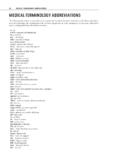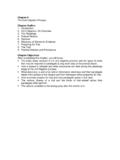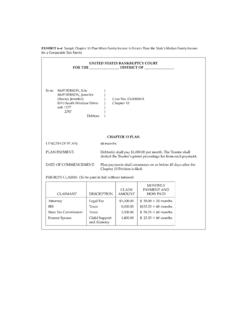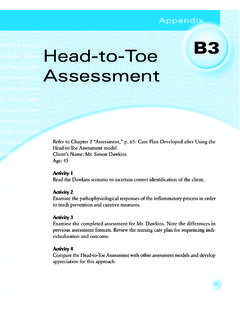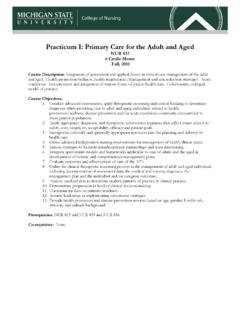Transcription of Medical classification and coding systems (in order …
1 Medical classification and coding systems (in order of development) coding system Description London Bills of Mortality Developed during the latter part of the 16th century Considered the first classification system Bills were collected and collated by parish clerks (with no Medical training). Nosologia Methodica Medical classification system developed in the mid-1700s by Fran ois Bossier de Lacroix (Sauvages) Bertillon International Statistical classification of Causes of Death classification of diseases by site, adopted in 1893 Subsequent revisions were entitled International List of Causes of Death (ICD-1, ICD-2, ICD-3, and ICD-4).
2 Classifications of diseases for morbidity reporting purposes were integrated into subsequent revisions. ICD-5 added mental diseases and deficiency (mental deficiency, schizophrenia, manic depressive psychosis, other mental diseases). In 1946, the World Health Organization (WHO) revised ICD-6 and established an International List of Causes of Morbidity. Manual of the International Statistical classification of Diseases, Injuries, and Causes of Death (ICD-6) Adopted internationally in 1948 by the First World Health Assembly WHO reviews and revises ICD about every 10 years: o ICD-7 (1955) o ICD-8 (1965) o ICD-9 (1975) o ICD-10 (1989, with WHO member states adopting in 1994) ICD-10 is entitled the International Statistical classification of Diseases and Related Health Problems (ICD-10) and differs from ICD-9, as follows: o More detailed (8,000 categories vs.)
3 4,000 in ICD-9) o Uses 3-digit alphanumeric category codes (vs. 3-digit numeric category codes in ICD-9) o Contains three additional chapters, and other chapters have been reorganized o Cause-of-death titles are modified and conditions reorganized o Some coding rules have changed o Published in three volumes (vs. two volumes in ICD-10) o The United States has not yet adopted ICD-10, and current implementation predictions are 2010. coding system Description International classification of Diseases, Adapted for use in the United States (ICDA) The United States adapted ICD-8 in 1966 to include additional detail for coding hospital and morbidity data, abbreviated ICDA-8.
4 In 1968, The Commission on Professional and Hospital Activities (CPHA) of Ann Arbor, Michigan, published a hospital adaptation of ICDA, entitled H-ICDA, which was revised in 1973 as H-ICDA-2. hospitals were divided in their use of ICDA-8 and H-ICDA (and later H-ICDA-2). Author Green recalls coding inpatient cases for the Medical record department using ICD-9-CM in 1979, while her utilization review coordinator coded the same cases according to H-ICDA as required by the county professional standards review organization (PSRO), which monitored the appropriateness, quality, and outcome of the services provided to beneficiaries of the Medicare, Medicaid, and Maternal and Child Health Programs.
5 In 1982, PSROs were replaced by statewide peer review organizations, or PROs. Effective 2002, they are called quality improvement organizations, or QIOs. In 1979, all hospitals were required to adopt the International classification of Diseases, Ninth Revision, Clinical Modification (ICD-9-CM), which classifies diagnoses (Volumes 1 & 2) and procedures (Volume 3) all hospitals and ambulatory care settings (including physician offices) use ICD-9-CM to report diagnoses; hospitals use ICD-9-CM procedure codes to report inpatient procedures and services. The National Center for Health Statistics (NCHS) is the federal agency responsible for developing ICD-10-CM.
6 The ICD-10-PCS (Procedure coding system ) was developed with support of the Health Care Financing Administration (now called Centers for Medicare & Medicaid Services) under contract to 3M Health Information systems . The National Committee on Vital Health and Statistics (NCVHS) serves as a public advisory body to the Secretary of DHHS in the development of ICD-10-PCS. ICD-10-CM and ICD-10-PCS have not yet been adopted for use in the United States. Once the final rule about adopting ICD-10-CM and ICD-10-PCS is published in the Federal Register, providers will have two years to implement the coding systems . The Federal Register is a legal newspaper published every business day by the National Archives and Records Administration (NARA) and is available in paper form, on microfiche, and online.
7 Medical classification and coding systems , page 2 coding system Description Diagnostic and Statistical Manual of Mental Disorders (DSM) Published by the american Psychiatric association as a standard classification of mental disorders used by mental health professionals in the United States o DSM (1952) o DSM-II (1968) o DSM-III (1980), and a multiaxial classification was added: Axis I mental disorders or illnesses ( , substance abuse) Axis II personality disorders or traits ( , mental retardation) Axis III general Medical illnesses ( , hypertension) Axis IV life events or problems ( , divorce) Axis V global assessment of functioning (GAF) ( , occupational) o DSM-III-R (1987) o DSM-IV (1994) o DSM-IV-TR (2000) (Text Revision to correct DSM-IV errors, update codes according to ICD-9-CM annual revisions, and so on) o DSM-V (expected in 2011)
8 Derived from ICD-9-CM, designed for use in a variety of health care settings, and consists of three major components: o Diagnostic classification o Diagnostic criteria sets o Descriptive text Medical classification and coding systems , page 3 coding system Description Current Procedural Terminology (CPT) Originally published by the american Medical association (AMA) in 1966 Subsequent editions were published about every five years, until the late 1980s when the AMA began publishing annual revisions of CPT-4 (now abbreviated as CPT). The CPT-5 Project was initiated by the AMA in 2000 to address challenges presented by emerging user needs, the Health Insurance Portability and Accountability Act of 1996 (HIPAA), and needed improvements in CPT.
9 The primary goal of the CPT-5 Project was to have CPT chosen by the Secretary of Health and Human Services as the national standard procedure code set for physician services under HIPAA. A Final Rule, issued in the August 17, 2000, Federal Register, named CPT as the national standard code set for physician services. CPT-5 Project recommendations are implemented annually along with code additions, deletions, and revisions. CPT classifies procedures and services. Physicians and ambulatory care settings ( , hospital outpatient care) assign CPT codes to report procedures and services. CPT is level I of the Healthcare Common Procedure coding system (HCPCS).
10 International classification of Diseases for Oncology, third edition (ICD-O-3) First edition of ICD-O was published in 1976, and a revision (primarily of topography codes) was published in 1990 ICD-O-3 was implemented in 2001. 10-digit code, which describes the tumor s primary site (4-character topography code), histology (4-digit cell type code), behavior (1-digit code for malignant, benign, and so on), and aggression (1-digit differentiation or grade code) International classification of Injuries, Disabilities, and Handicaps (ICIDH) Published in 1980, ICIDH classifies health and health-related domains that describe body functions and structures, activities, and participation.
